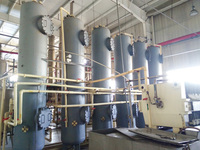Process of tapioca starch production
Specifications
One kilogram of tapioca starch requires 4.4 kilograms of fresh cassava roots at its starch content of 25%.
In Thailand, the large-scale processing facilities with advanced processing machines and technology have been replacing those
primitive and small-scale factories. According to the studies, the processing methods could be divided into two processes; traditional
and modern. Their details are as follows:
The traditional process, usually practiced in the small-scale factories, is able to separate starch from fresh cassava roots by crushing
and then submerging the cassava under the water. The starch made through this process is inferior in quality.
Old way of peeling tapioca tuber
Compared to the traditional process, the modern process of tapioca starch production, practiced in the large-and-medium-scale
factories relies on numbers of highly efficient equipment and machines; Grinding the starch with the high-speed Rasper. Then extract
the protein by the machine. Separated the water by the “Centrifuge”. Dry the cake in the flash dryer. This process requires only short
period of time and provides superior quality of starch.
The process of tapioca starch production may be described into 8 steps as follows:
1. Weigh the fresh tapioca roots to determine the starch percentage.
2. Remove sand and impurity in the rotary screener.
3. Put it into the peeling-and-cleansing device,to get the cleaning tapioca.
4. Put the fresh clean tapioca into the Rasper and remove protein.
5. Pass the slurry through the screen to remove fiber. Fiber is sun-dried and sold out for animal feed application.
6. Separate the fine fiber and impurity by “Centrifuge”.
7. Dry out the starch by passing it through the hot-aired dryer column.
8. Pass the starch through the sifter and pack the fine powder into the sacks for sale.
phone:0086-18438491113
Whatsapp:0086-18438491113
email:sida@cnstarchmachine.com
https://www.syrupmachinery.com
In Thailand, the large-scale processing facilities with advanced processing machines and technology have been replacing those
primitive and small-scale factories. According to the studies, the processing methods could be divided into two processes; traditional
and modern. Their details are as follows:
The traditional process, usually practiced in the small-scale factories, is able to separate starch from fresh cassava roots by crushing
and then submerging the cassava under the water. The starch made through this process is inferior in quality.
Old way of peeling tapioca tuber
Compared to the traditional process, the modern process of tapioca starch production, practiced in the large-and-medium-scale
factories relies on numbers of highly efficient equipment and machines; Grinding the starch with the high-speed Rasper. Then extract
the protein by the machine. Separated the water by the “Centrifuge”. Dry the cake in the flash dryer. This process requires only short
period of time and provides superior quality of starch.
The process of tapioca starch production may be described into 8 steps as follows:
1. Weigh the fresh tapioca roots to determine the starch percentage.
2. Remove sand and impurity in the rotary screener.
3. Put it into the peeling-and-cleansing device,to get the cleaning tapioca.
4. Put the fresh clean tapioca into the Rasper and remove protein.
5. Pass the slurry through the screen to remove fiber. Fiber is sun-dried and sold out for animal feed application.
6. Separate the fine fiber and impurity by “Centrifuge”.
7. Dry out the starch by passing it through the hot-aired dryer column.
8. Pass the starch through the sifter and pack the fine powder into the sacks for sale.
phone:0086-18438491113
Whatsapp:0086-18438491113
email:sida@cnstarchmachine.com
https://www.syrupmachinery.com
- Country: China (Mainland)
- Business Type: 选择一个
- Founded Year: 1994
- Contact: zhang xiansheng





